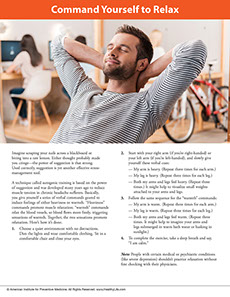Command Yourself to Relax

Print on Demand
Imagine scraping your nails across a blackboard or biting into a raw lemon. Either thought probably made you cringe—the power of suggestion is that strong. Used correctly, suggestion is yet another effective stress-management tool.
A technique called autogenic training is based on the power of suggestion and was developed many years ago to reduce muscle tension in chronic headache sufferers. Basically, you give yourself a series of verbal commands geared to induce feelings of either heaviness or warmth. “Heaviness” commands promote muscle relaxation; “warmth” commands relax the blood vessels, so blood flows more freely, triggering sensations of warmth. Together, the two sensations promote relaxation. Here’s how it’s done.
1. Choose a quiet environment with no distractions. Dim the lights and wear comfortable clothing. Sit in a comfortable chair and close your eyes.
2. Start with your right arm (if you’re right-handed) or your left arm (if you’re left-handed), and slowly give yourself these verbal cues:
- My arm is heavy. (Repeat three times for each arm.)
- My leg is heavy. (Repeat three times for each leg.)
- Both my arms and legs feel heavy. (Repeat three times.) It might help to visualize small weights attached to your arms and legs.
3. Follow the same sequence for the “warmth” commands:
- My arm is warm. (Repeat three times for each arm.)
- My leg is warm. (Repeat three times for each leg.)
- Both my arms and legs feel warm. (Repeat three times. It might help to imagine your arms and legs submerged in warm bath water or basking in sunlight.)
4. To complete the exercise, take a deep breath and say, “I am calm.”
Note: People with certain medical or psychiatric conditions (like severe depression) shouldn’t practice relaxation without first checking with their physicians.
This website is not meant to substitute for expert medical advice or treatment. Follow your doctor’s or health care provider’s advice if it differs from what is given in this guide.
The American Institute for Preventive Medicine (AIPM) is not responsible for the availability or content of external sites, nor does AIPM endorse them. Also, it is the responsibility of the user to examine the copyright and licensing restrictions of external pages and to secure all necessary permission.
The content on this website is proprietary. You may not modify, copy, reproduce, republish, upload, post, transmit, or distribute, in any manner, the material on the website without the written permission of AIPM.
2019 © American Institute for Preventive Medicine - All Rights Reserved. Disclaimer | www.HealthyLife.com




